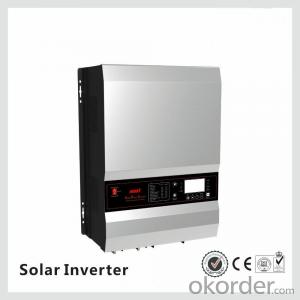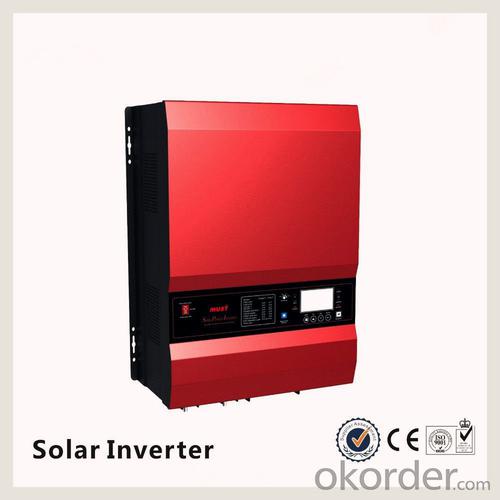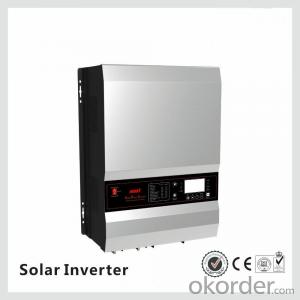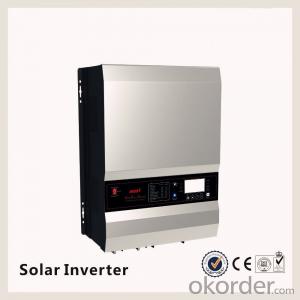60 Kw Solar Inverter PV35-2K Low Frequency DC to AC Solar Power Inverter 12KW
- Loading Port:
- Shanghai
- Payment Terms:
- TT OR LC
- Min Order Qty:
- 1000 watt
- Supply Capability:
- 100000 watt/month
OKorder Service Pledge
OKorder Financial Service
You Might Also Like
Product Description
What is Solar inverter?
Solar pv inverters is an electronic system that operates the photovoltaic(PV) modules in a manner that allows the modules to produce all the power they are capable of. The solar mate charge controller is a microprocessor-based system designed to implement the MPPT. It can increase charge current up to 30% or more compared to traditional charge controllers.
Features
· Power range 1KW - 12KW
· Inbuilt pure copper transformer
· Powerful charge rate up to 100Amp
· MPPT solar charge controller 45A 60A (120A Option)
· PV input:145V max
· 12V/24V/36V/48V auto work
· MPPT efficiency>99% , Peak conversion efficiency>98%
· DSP processors architecture ensure high speed and performance
· Four-stages charging mode
· Protection: PV array short circuit, PV reverse polarity, Battery reverse polarity, Over charging, Output short circuit
· High efficency design & "Power Saving Mode" to coverse energy
Specification
MODEL | PV35-1K | PV35-2K | PV35-3K | PV35-4K | |||||||||||||||
Default Battery System Voltage | 12VDC | 24VDC | 12VDC | 24VDC | 12VDC | 24VDC | 12VDC | 24VDC | |||||||||||
INVERTER OUTPUT | Rated Power | 1KW | 2KW | 3000VA/2.4KW | 4000VA/3.2KW | ||||||||||||||
Surge Rating (20ms) | 3KW | 6KW | 9KW | 12KW | |||||||||||||||
Capable Of Starting Electric Motor | 1HP | 1HP | 1.5HP | 2HP | |||||||||||||||
Waveform | Pure sine wave/ same as input (bypass mode) | ||||||||||||||||||
Nominal Output Voltage RMS | 100V/110V/120VAC 220V/230V/240VAC(+/-10% RMS) | ||||||||||||||||||
Output Frequency | 50Hz/60Hz +/-0.3 Hz | ||||||||||||||||||
Inverter Efficiency(Peak) | >88% | ||||||||||||||||||
Line Mode Efficiency | >95% | ||||||||||||||||||
Power Factor | 0.8 | ||||||||||||||||||
Typical Transfer Time | 10ms(max) | ||||||||||||||||||
AC INPUT | Voltage | 230VAC | |||||||||||||||||
Selectable Voltage Range | 96~132VAC/155~280VAC(For Personal Computers) | ||||||||||||||||||
Frequency Range | 50Hz/60Hz (Auto sensing) 40-80Hz | ||||||||||||||||||
BATTERY | Minimum Start Voltage | 10.0VDC /10.5VDC for12VDC mode (*2 for 24VDC, *4 for 48VDC) | |||||||||||||||||
Low Battery Alarm | 10.5VDC+/-0.3V for12VDC mode (*2 for 24VDC, *4 for 48VDC) | ||||||||||||||||||
Low Battery Cutoff | 10.0VDC+/-0.3V for12VDC mode (*2 for 24VDC, *4 for 48VDC) | ||||||||||||||||||
High Voltage Alarm | 16.0VDC+/-0.3V for12VDC mode (*2 for 24VDC, *4 for 48VDC) | ||||||||||||||||||
High Battery Voltage Recover | 15.5VDC+/-0.3V for12VDC mode (*2 for 24VDC, *4 for 48VDC) | ||||||||||||||||||
Idle Consumption-Search Mode | <25W when power saver on | ||||||||||||||||||
CHARGER | Output Voltage | Depends on battery type | |||||||||||||||||
Charger AC Input Breaker Rating | 10A | 30A | 30A | 30A | |||||||||||||||
Overcharge Protection S.D. | 15.7VDC for 12VDC mode (*2 for 24VDC, *4 for 48VDC) | ||||||||||||||||||
Maximum Charge Current | 45A | 25A | 70A 35A | 90A 50A | 65A 40A | ||||||||||||||
BTS | Continuous Output Power | Yes Variances in charging voltage & S.D. voltage base on the battery temperature | |||||||||||||||||
BYPASS & PROTECTION | Input Voltage Waveform | Sine wave (grid or generator) | |||||||||||||||||
Nominal Input Frequency | 50Hz or 60Hz | ||||||||||||||||||
Overload Protection (SMPS Load) | Circuit breaker | ||||||||||||||||||
Output Short Circuit Protection | Circuit breaker | ||||||||||||||||||
Bypass Breaker Rating | 10A | 15A | 20A | 40A | |||||||||||||||
Max Bypass Current | 30Amp | ||||||||||||||||||
SOLAR CHARGER | Maximum PV Charge Current | 45A | |||||||||||||||||
DC Voltage | 12V/24V atuo work | ||||||||||||||||||
Maximum PV Array Power | 600W | 1200W | 600W | 1200W | 600W | 1200W | 600W | 3200W | |||||||||||
MPPT Range @ Operating Voltage(VDC) | 16-100VDC for 12V mode,32-100V for 24V mode | ||||||||||||||||||
Maximum PV Array Open Circuit Voltage | 100VDC | 147VDC | |||||||||||||||||
Maximum Efficiency | >98% | ||||||||||||||||||
Standby Power Consumption | <2w< span=""> | ||||||||||||||||||
MECHANICAL SPECIFICATIONS | Mounting | Wall mount | |||||||||||||||||
Dimensions (W*H*D) | 493*311*215mm | ||||||||||||||||||
Net Weight (Solar CHG) kg | 23.5 | 24.5 | 25.5 | 29.5 | |||||||||||||||
Shipping Dimensions(W*H*D) | 580*400*325mm | ||||||||||||||||||
Shipping Weight (Solar CHG) kg | 25.5 | 26.5 | 27.5 | 31.5 | |||||||||||||||
OTHER | Operation Temperature Range | 0°C to 40°C | |||||||||||||||||
Storage Temperature | -15°C to 60°C | ||||||||||||||||||
Audible Noise | 60dB MAX | ||||||||||||||||||
Display | LED+LCD | ||||||||||||||||||
Loading(20GP/40GP/40HQ) | 150pcs/300pcs/350pcs | ||||||||||||||||||
Images
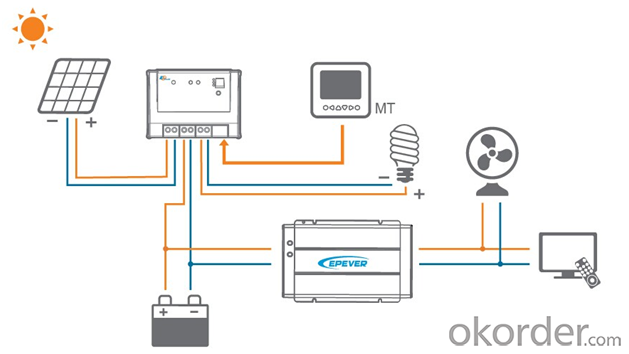
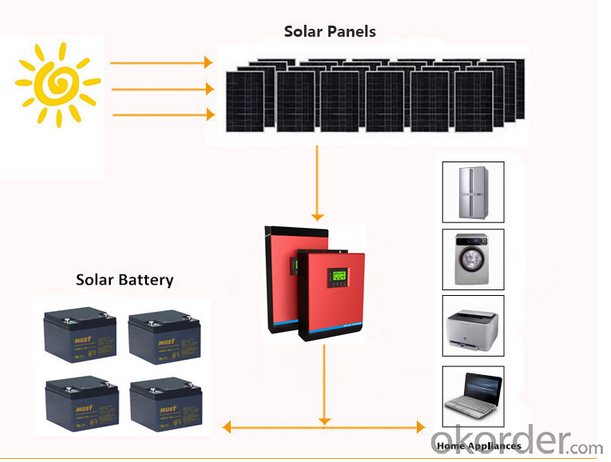
Packaging & Shipping
What is the packing?
1.Package: Carton Box for packaging, or Wooden Box advised for Samples to protect in transportations. Package designed by Clients is welcomed.
2.Shipping: DHL,FEDEX,UPS,EMS,AirWay and By Sea.
3.Payment: T/T( telegraphic transfer (T/T) and Western Union
4.Welcome to your Sample Order to test First.
FAQ
Q1: How to choose a right inverter?
A1:Tell us your demand, then our sales will recommend a suitable inverter to you.
Q2: What's the different between inverter and solar inverter?
A2: Inverter is only accept AC input, but solar inverter not only accept AC input but also can connect with solar panel to accept PV input, it more save power.
Q3: How about the delivery time?
A3: 7 days for sample; 25 days for bulk order.
- Q: Are there any government regulations or certifications for solar inverters?
- Yes, there are government regulations and certifications for solar inverters. These regulations vary by country and region, but typically involve safety standards, grid compatibility requirements, and product testing procedures. Additionally, various certifications such as UL, IEC, and CE are commonly required to ensure the quality and reliability of solar inverters in the market.
- Q: How does a solar inverter handle variations in ambient temperature?
- A solar inverter handles variations in ambient temperature by incorporating temperature compensation mechanisms. These mechanisms allow the inverter to adjust its operation and optimize performance based on the temperature conditions. By monitoring the temperature, the inverter can regulate voltage levels, adjust power outputs, and protect itself from overheating. This ensures that the inverter operates efficiently and reliably under different ambient temperature conditions.
- Q: Can a solar inverter be used with different types of solar panels?
- Yes, a solar inverter can typically be used with different types of solar panels. Solar inverters are designed to convert the direct current (DC) generated by solar panels into alternating current (AC) that can be used to power various electrical devices. As long as the solar panels produce compatible DC voltage and current, they can be connected to the solar inverter regardless of their type, such as monocrystalline, polycrystalline, or thin-film panels. However, it is important to ensure that the solar inverter is appropriately sized and compatible with the total capacity of the connected solar panels for optimal performance.
- Q: How does a solar inverter handle grid frequency deviations?
- A solar inverter handles grid frequency deviations by constantly monitoring the grid frequency. When the grid frequency deviates from the standard range, the inverter adjusts its output frequency accordingly to match the grid frequency. This allows the inverter to maintain synchronization with the grid and continue injecting power efficiently, ensuring stability and reliability of the solar power system.
- Q: Can a solar inverter be used with different types of solar cell technologies?
- Yes, a solar inverter can be used with different types of solar cell technologies. Solar inverters are designed to convert the DC electricity generated by solar panels, regardless of the type of solar cell technology, into AC electricity that can be used to power homes and businesses. Therefore, whether it is monocrystalline, polycrystalline, thin-film, or any other solar cell technology, a solar inverter can efficiently convert the generated electricity into usable form.
- Q: What is the maximum power capacity that a solar inverter can handle?
- The maximum power capacity that a solar inverter can handle depends on its specific model and specifications. In general, solar inverters can handle power capacities ranging from a few hundred watts to several megawatts, catering to various residential, commercial, and utility-scale solar installations.
- Q: Can a solar inverter be used with a solar-powered desalination system?
- Yes, a solar inverter can be used with a solar-powered desalination system. A solar inverter is responsible for converting the direct current (DC) produced by solar panels into alternating current (AC) that is required to power electrical devices. In the case of a solar-powered desalination system, the solar panels generate DC electricity, which is then converted by the inverter to AC power to operate the desalination system's pumps, motors, and other electrical components. This allows the system to utilize solar energy efficiently and sustainably for the desalination process.
- Q: Are solar inverters weatherproof?
- Yes, solar inverters are typically weatherproof and designed to withstand different weather conditions such as rain, snow, and heat. However, it is essential to ensure that the solar inverter is installed correctly and protected from extreme weather conditions to maintain its performance and longevity.
- Q: What is the role of a power control feature in a solar inverter?
- The role of a power control feature in a solar inverter is to regulate and optimize the flow of electricity from the solar panels to the electrical grid or to the connected devices. It ensures that the power generated by the solar panels is converted and delivered efficiently, while also monitoring the voltage and frequency levels to maintain a stable and reliable power supply. Additionally, the power control feature enables the inverter to synchronize with the grid and comply with local regulations and requirements.
- Q: What is the maximum DC input voltage for a solar inverter?
- The maximum DC input voltage for a solar inverter typically depends on the specific model and manufacturer. However, in general, the maximum DC input voltage for a solar inverter can range from around 500 volts to 1000 volts or more. It is important to consult the manufacturer's specifications for the specific solar inverter being used to determine the exact maximum DC input voltage.
Send your message to us
60 Kw Solar Inverter PV35-2K Low Frequency DC to AC Solar Power Inverter 12KW
- Loading Port:
- Shanghai
- Payment Terms:
- TT OR LC
- Min Order Qty:
- 1000 watt
- Supply Capability:
- 100000 watt/month
OKorder Service Pledge
OKorder Financial Service
Similar products
Hot products
Hot Searches
Related keywords

